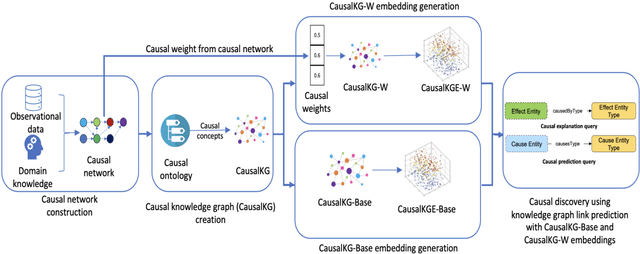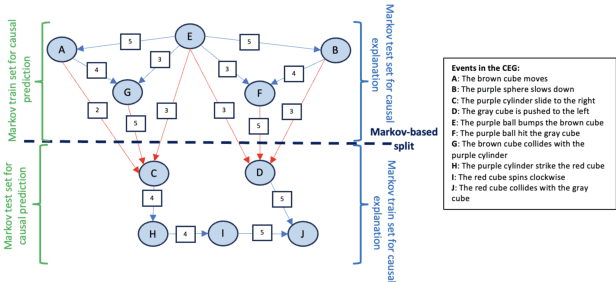Utkarshani Jaimini
CausalDisco: Causal discovery using knowledge graph link prediction
Apr 23, 2024



Abstract:Causal discovery is a process of discovering new causal relations from observational data. Traditional causal discovery methods often suffer from issues related to missing data To address these issues, this paper presents a novel approach called CausalDisco that formulates causal discovery as a knowledge graph completion problem. More specifically, the task of discovering causal relations is mapped to the task of knowledge graph link prediction. CausalDisco supports two types of discovery: causal explanation and causal prediction. The causal relations have weights representing the strength of the causal association between entities in the knowledge graph. An evaluation of this approach uses a benchmark dataset of simulated videos for causal reasoning, CLEVRER-Humans, and compares the performance of multiple knowledge graph embedding algorithms. In addition, two distinct dataset splitting approaches are utilized within the evaluation: (1) random-based split, which is the method typically used to evaluate link prediction algorithms, and (2) Markov-based split, a novel data split technique for evaluating link prediction that utilizes the Markovian property of the causal relation. Results show that using weighted causal relations improves causal discovery over the baseline without weighted relations.
CausalKG: Causal Knowledge Graph Explainability using interventional and counterfactual reasoning
Jan 06, 2022



Abstract:Humans use causality and hypothetical retrospection in their daily decision-making, planning, and understanding of life events. The human mind, while retrospecting a given situation, think about questions such as "What was the cause of the given situation?", "What would be the effect of my action?", or "Which action led to this effect?". It develops a causal model of the world, which learns with fewer data points, makes inferences, and contemplates counterfactual scenarios. The unseen, unknown, scenarios are known as counterfactuals. AI algorithms use a representation based on knowledge graphs (KG) to represent the concepts of time, space, and facts. A KG is a graphical data model which captures the semantic relationships between entities such as events, objects, or concepts. The existing KGs represent causal relationships extracted from texts based on linguistic patterns of noun phrases for causes and effects as in ConceptNet and WordNet. The current causality representation in KGs makes it challenging to support counterfactual reasoning. A richer representation of causality in AI systems using a KG-based approach is needed for better explainability, and support for intervention and counterfactuals reasoning, leading to improved understanding of AI systems by humans. The causality representation requires a higher representation framework to define the context, the causal information, and the causal effects. The proposed Causal Knowledge Graph (CausalKG) framework, leverages recent progress of causality and KG towards explainability. CausalKG intends to address the lack of a domain adaptable causal model and represent the complex causal relations using the hyper-relational graph representation in the KG. We show that the CausalKG's interventional and counterfactual reasoning can be used by the AI system for the domain explainability.
How will the Internet of Things enable Augmented Personalized Health?
Dec 31, 2017

Abstract:Internet-of-Things (IoT) is profoundly redefining the way we create, consume, and share information. Health aficionados and citizens are increasingly using IoT technologies to track their sleep, food intake, activity, vital body signals, and other physiological observations. This is complemented by IoT systems that continuously collect health-related data from the environment and inside the living quarters. Together, these have created an opportunity for a new generation of healthcare solutions. However, interpreting data to understand an individual's health is challenging. It is usually necessary to look at that individual's clinical record and behavioral information, as well as social and environmental information affecting that individual. Interpreting how well a patient is doing also requires looking at his adherence to respective health objectives, application of relevant clinical knowledge and the desired outcomes. We resort to the vision of Augmented Personalized Healthcare (APH) to exploit the extensive variety of relevant data and medical knowledge using Artificial Intelligence (AI) techniques to extend and enhance human health to presents various stages of augmented health management strategies: self-monitoring, self-appraisal, self-management, intervention, and disease progress tracking and prediction. kHealth technology, a specific incarnation of APH, and its application to Asthma and other diseases are used to provide illustrations and discuss alternatives for technology-assisted health management. Several prominent efforts involving IoT and patient-generated health data (PGHD) with respect converting multimodal data into actionable information (big data to smart data) are also identified. Roles of three components in an evidence-based semantic perception approach- Contextualization, Abstraction, and Personalization are discussed.
 Add to Chrome
Add to Chrome Add to Firefox
Add to Firefox Add to Edge
Add to Edge